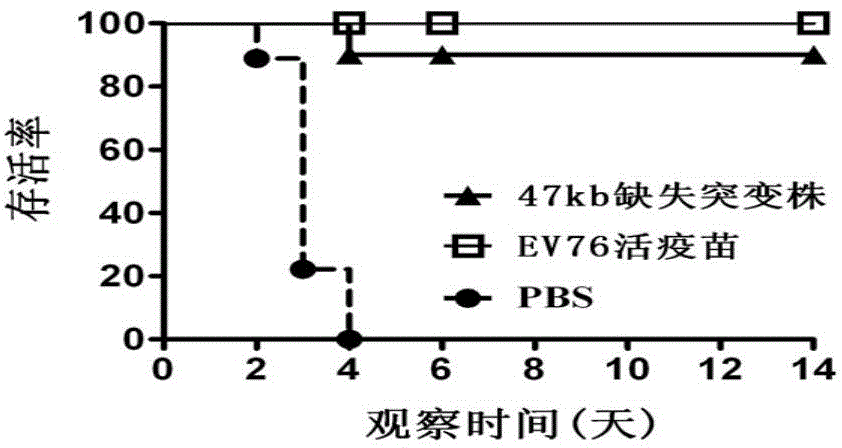Yersinia pestis virulence regulator TyrR and applications thereof
A technology of Yersinia pestis and virulence regulator, applied in the field of genetic engineering, can solve the problem of incomplete understanding of the pathogenicity of Yersinia pestis
- Summary
- Abstract
- Description
- Claims
- Application Information
AI Technical Summary
Problems solved by technology
Method used
Image
Examples
Embodiment 1
[0039] Example 1 Discovery and Identification of 47kb Virulent Large Fragment
[0040] RyhB is a small RNA related to iron metabolism. Yersinia pestis has 2 copies of small RNA (RyhB1 and RyhB2) with a length of about 100bp. In the construction of the Yersinia pestis RyhB mutant strain, the application of the traditional one-step gene mutation technique was unsuccessful. In this example, two-step PCR was used to successfully construct △ryhB1 and △ryhB2 single-deleted strains, and the △ryhB1-deleted strain was constructed on the basis of △ryhB1::ryhB2 double deletion strain LD 50 Up to 1.5×10 6 CFU (see Table 1), the virulence is about 100,000 times lower than that of the wild strain, while the RyhB1 and RyhB2 single mutant strain LD 50 <8CFU, does not cause a drop in toxicity.
[0041] 1. The method of two-step PCR knockout gene is as follows:
[0042] (1) PCR amplification of the upstream and downstream homology arms and kanaboxes of the target gene to be knocked out. Pri...
Embodiment 2
[0054] Example 2 Determination of F1 antibody and immune protection effect of Yersinia pestis 47kb deletion strain
[0055] 1. Determination of F1 antibody of Yersinia pestis 47kb deletion strain: F1 antigen is an important neutralizing antigen of Yersinia pestis, and the humoral immune response ability of the vaccine can be reflected by measuring F1 neutralizing antibody. The mean F1 antibody titers produced between the two dose groups of Yersinia pestis 47kb large fragment deletion strain (and EV76 live vaccine) were 761.3±1.53 and 656.3±1.77 respectively, and there was no statistically significant difference (t=0.44, P>0.05), It shows that the large fragment of Yersinia pestis produces better humoral immune response after deletion of the 47kb large fragment, and the effect is similar to that of the traditional EV76 live vaccine (see figure 2 ).
[0056] The specific method is as follows: Three groups of BALB / c mice (ten mice in each group) were subcutaneously immunized wi...
Embodiment 3
[0058] Example 3 Discovery of Yersinia pestis virulence regulator TyrR
[0059] From the results of Example 1, it can be seen that the gene knockout technology based on Red homologous recombination in the present invention deletes the 47kb large fragment of Yersinia pestis, and after the 47kb deletion, the LD 50 1.5×10 6 CFU, the virulence is about 100,000 times lower than that of the wild strain, and it can produce F1 antibody and has good immune protection effect, so it can be used in the preparation of vaccines.
[0060] In order to further determine the gene attenuated after the deletion of the 47kb large fragment, the present invention adopts segmental knockout and LD 50 Experiment with combining strategies. The stepwise gene knockout method in this embodiment adopts the one-step gene knockout method and the two-step gene knockout method respectively. The one-step gene knockout method is to directly use PCR to amplify the linear mutation cassette, use the λRed system t...
PUM
| Property | Measurement | Unit |
|---|---|---|
| antibody titer | aaaaa | aaaaa |
Abstract
Description
Claims
Application Information
 Login to View More
Login to View More - R&D
- Intellectual Property
- Life Sciences
- Materials
- Tech Scout
- Unparalleled Data Quality
- Higher Quality Content
- 60% Fewer Hallucinations
Browse by: Latest US Patents, China's latest patents, Technical Efficacy Thesaurus, Application Domain, Technology Topic, Popular Technical Reports.
© 2025 PatSnap. All rights reserved.Legal|Privacy policy|Modern Slavery Act Transparency Statement|Sitemap|About US| Contact US: help@patsnap.com



